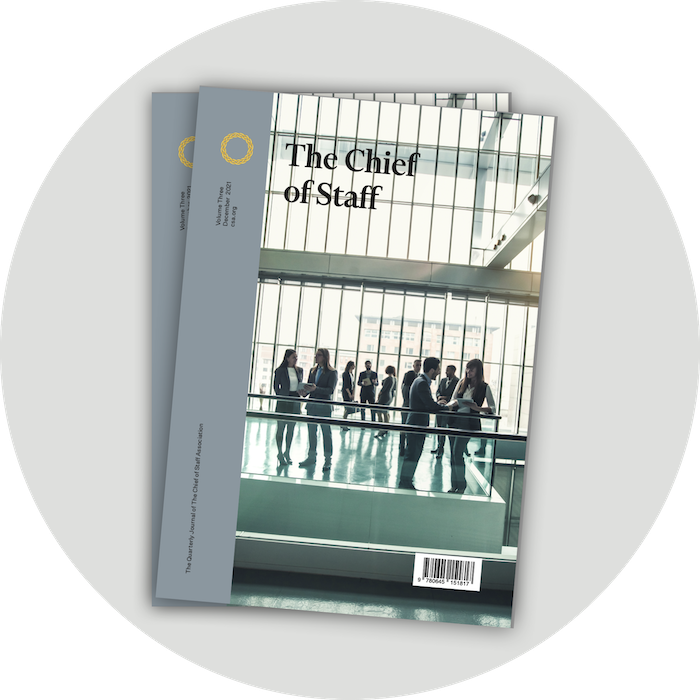Eryn-Ashlei Bailey, chief of staff at Allurion Technologies, sums up the universal challenges of the chief of staff role.
For all that is uncertain about the Chief of Staff role, there are several universal challenges. A chief of staff faces these challenges at different times, and to varying degrees. As chief of staff, your role may be poorly understood. Your impact will vary depending on the team that you work with. Your team may never consider you as a peer. Deftly overcoming these challenges enacts the espoused values of your principal, and limits disruption to your principal’s agenda…all in a day’s work.
Depending on the size and structure of the organization, it can take between six to nine months to demonstrate the scope and function of the chief of staff role. After the scope and function of the chief of staff role is better understood, you can truly get to work. As you mature in the chief of staff role, you earn respect, and you have wider reach within an organization. As with all endeavors, begin with the end in mind. Ask yourself, ‘What do I want my legacy to be?’ Craft a wish list of three strategic and/or cultural impacts that you hope to associate with your time as chief of staff. Work closely with your principal to align on vision, objectives, and measures of success, to ensure that you’re delivering on what’s most important to your principal.
Ask yourself, ‘What do I want my legacy to be?’
A clear set of goals, established by your principal, can elucidate your mandate as chief of staff. When I started as a chief of staff, my mentor encouraged me to explain what my role ‘is,’ and what my role ‘is not,’ when people ask about what I do. Describing what you do, and setting boundaries on what you do not do, will differentiate the chief of staff role from other core functions. Clarity drives efficiency and increases impact. Seek clarity.
If you’re motivated enough to seek a chief of staff role, you’re likely seeking an opportunity to make an impact on your team, in your company, and even in your industry. The reality is that the chief of staff portfolio of projects can include several individual contributor projects, but will likely include projects completed by cross functional teams. Your ability to make change depends on the team that you work with. As teams vary, so will your impact vary also. Just starting a conversation may be your most important contribution to a project or strategic initiative. A smart chief of staff knows when to swoop into a project. An adroit chief of staff knows when to pull up, when to involve others, and when to move on to the next project.
“An adroit chief of staff knows when to pull up, when to involve others, and when to move on to the next project.”
Power is given, not taken. Power will be given to you by your teammates after you’ve listened, learned, and shown a keen interest in advancing their success. There are three categories of people in every company. Category one people will immediately buy into your role and invite your input. Category two people will need more time than others to adjust to your role, and by proxy, to you. Category three people will resist you altogether. Focus on category one and category two people. Eventually, category three people will start to work more with you. A given percentage of people in any company will not work with you. In those cases, your focus should be on those who will work with you.
Perhaps one of the trickiest dynamics to navigate as a chief of staff is the peer dynamic. The peer dynamic has many facets. Questions like, ‘Who are my peers,’ and ‘What do my peers expect from me and vice versa,’ will arise. The answers to those questions are likely to shift and change over time. As chief of staff, one of your most valuable assets is your reputation as a trusted confidant. Managing perceptions of your personal brand is essential. Personal brand management is crucial to your credibility as chief of staff.
Once the perception of your role crystallizes, you will need to intentionally manage yourself with very acute self-awareness. Be authentic, but steer clear of venting to people in your organization. Your words hold weight. Be friendly, and when you form friendships, keep the friendship centered on non-work activities.
Despite your best efforts to come alongside your peers to solve problems, your team may never see you as a peer. The core of the chief of staff role is finding broken windows to fix. That mandate can cause your peers to ‘close the shutters,’ so to speak. The equipped chief of staff should be emotionally intelligent enough to discern those dynamics but must resolve not to be undone when they play out. The chief of staff must carry forward with the strong relationships that she’s formed and execute on her principal’s objectives. Forward march!
“Embrace the challenges. The rewards are so worth it.”
These are a few of the challenges that a chief of staff will encounter. Identifying challenges, tapping into internal resources to overcome them, and seeing challenges through to breakthrough solutions, will be inherently rewarding. On the other side of challenge is triumph. In ideal situations, the other side of challenge is new found depth in work relationships that would not have existed otherwise. Embrace the challenges. The rewards are so worth it.
Eryn-Ashlei Bailey is a Chief of Staff at a medtech company that is commercial in over 45 countries. She has worked as a Chief of Staff in the multi family office space as well. Eryn started a LinkedIn series about what the daily life of a Chief of Staff is like. She is based in the Boston area.
This article was first published as ‘The Challenges of the Chief of Staff’, February 9, 2022, https://www.linkedin.com/pulse/challenges-chief-staff-eryn-ashlei-bailey/.


